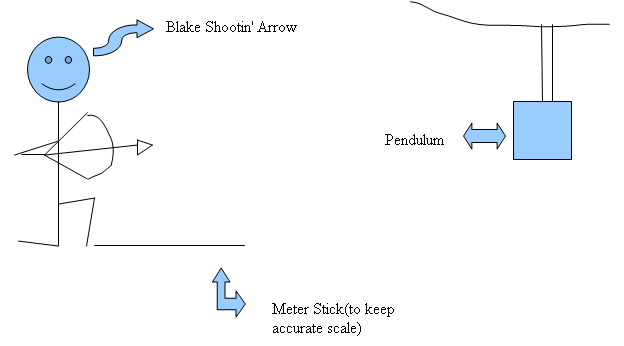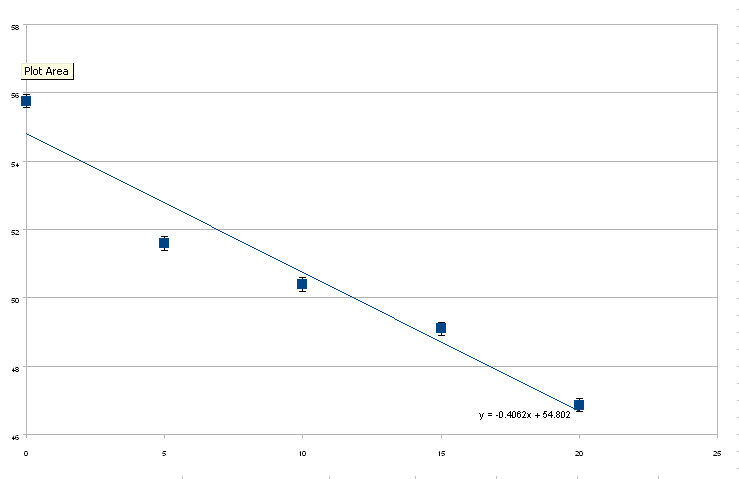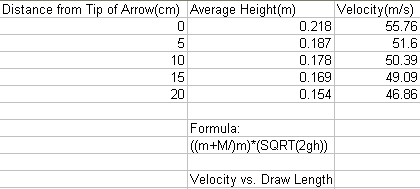Blake Arellano
Austin Smith
Kelly Schiller
Table of Contents .:. Go Up
Arrowheads were first discovered in Africa, which leads us to believe that the bow and arrow were invented there as as 50,000 BC (Jeffrey, 2008). The longbow is traced back as far as the early 12th century A.D. It brought with it a new form of combat not seen before. Knights could be killed at a much further distance than before. Modern tests have shown that an arrow can pierce 9cm of oak at close range and 2.5cm at a distance 200 yards (Anton). This meant that not only was the longbow firing the arrows an incredibly long distance, but it was firing them at a high speed.
When using a longbow, the force on the fingers steadily increases as you draw back. This force on the fingers that varies with the different lengths of your draws is called the draw force curve. The force curve determines the amount of energy stored in the bow when it is fully drawn, and what force is transfered to the arrow. To determine the amount of weight on the fingers, the equation 2FCos(a)Cos(b) is used (Clark, 2001). The tension in the bowstring is simply given by the equation Fcos(a). 'F' is the Force and A is the angle between the string and force direction (Clark, 2001).
We will ultimately be finding the velocity of the arrow in relation to the draw length of the bow. To do this, we will be firing an arrow into a pendulum. The pendulum should conserve the potential energy of the arrow through kinetic energy. To calculate this, we will use the equation ((m+M)/m)(SQRT(2gh)).
The purpose of our investigation is to determine the relationship between the draw length of the bow to the velocity of the arrow being fired.
We believe that the greater the draw length of the bow, the greater the force the arrow will exert upon the pendulum. This is because the greater the tension on the bow, the more energy is stored, and thus transfered to the arrow. This in the end will make the arrow go at faster speeds as the draw length is increased.
To calculate the velocity of the arrow, we filmed Blake shooting it at a pendulum. The pendulum was constructed out of a cardboard box that was filled with lots of recycled paper and heavily wrapped in duct tape. We used the paper to slow the arrow so it would not leave the pendulum after impact. We used two ropes tied to the box and a tree branch to makes sure it wouldn't sway from side to side after impact. The goal was to make the pendulum lightweight, but stop the arrow at the same time. We filmed from a distance of roughly 30 yards, and zoomed in to reduce paralax. We fired the arrow from five different draw distances (Full draw, 5cm from full draw, 10, 15, and 20), and did four trials from each of those distances. We marked a spot on the ground so Blake would shoot from the same spot everytime, and tried to get him to shoot fairly level with the pendulum. We also place a meter stick in front of him so we could get an accurate scale during our video analysis. We uploaded our videos onto LoggerPro, and began video analysis. We measured the vertical displacement in every trial and averaged the four trials from each draw length. We took these heights and plugged them into our equation ((m+M)/m)(SQRT(2gh)) to calculate the average velocity of the arrow from each draw length. We plugged the numbers into LoggerPro and created an X-Y Scatter Plot graph of hour data to analyze our results.

-Longbow -Camera
-Arrow -Meter Stick
-Cardboard Box -Duct Tape
-Recycled Paper -Good Aim!


In conclusion, our hypothesis was correct. The further back we drew the bow, the faaster the arrow would travel. Not only was our hypothesis correct, but when analyzizing our data, we found that the relationship between draw length and velocity is linear. We think this is because the potential energy in the longbow is equivalent to the kinetic energy in the arrow (mgh=1/2mv^2). We definitely had many sources of error that occurred in our experiement. We did not take into account air resistance, which most certainly would've made an impact on the day we shot. The wind was strong that day, and had conditions been different, our results might have changed. We also did not fire the arrow directly perpendicular to the pendulum. Although we tried to get as close as possible, we know we weren't exact. On the video analysis, we saw that box swayed slightly from side to side. Because of this, we couldn't measure from the center of box and had to measure from a corner. This could have an affect on the actual vertical displacement of our pendulum. If we were to perform this experiment again, I think we would do it in a controlled environment; somewhere that we don't have to worry about environmental factors. We would also constrict the movement of the pendulum with a better setup. Ours swayed slightly and to get a completely accurate height, we have to eliminate that swaying. We would also fire directly perpendicular to the box. All in all, I think our results still hold up as a good representation of the direct correlation between a bow's draw length, and the velocity of the arrow being fired.
Clark, James, The Physics of Archery, 2001, <http://www.mrfizzix.com/archery/index.html>
Kooi, Bob; Bow-Arrow Interaction in Archery Journal of sport
Sciences Vol. 16 pages 721-731 1998 <http://www.bio.vu.nl/thb/users/kooi/kooi97b.pdf
>
Jeffrey, Graeme. "'A Shot in Time'." Centenary Archers. 1999-2008. Centenary Archers Club Inc., Web. 29 Oct 2009. <http://www.centenaryarchers.gil.com.au/history.htm>.
Anton, . "A Short History of the English Longbow." n. pag. Web. 21 Jan 2010. http://www.archers.org/default.asp?section=History&page=longbow
How to shoot a Bow: http://www.ehow.com/how_11356_shoot-bow.html
History of the Bow and Arrow: http://www.articlesbase.com/extreme-sports-articles/history-of-the-bow-and-arrow-403289.html
Physics of Archery: http://www.mrfizzix.com/archery/index.html
Equations and Different Models for Bow Shooting: http://www.bio.vu.nl/thb/users/kooi/kooi97b.pdf
History of Archery (use as a weapon throughout time): http://www.centenaryarchers.gil.com.au/history.htm
History of the English Longbow: http://www.archers.org/default.asp?section=History&page=longbow